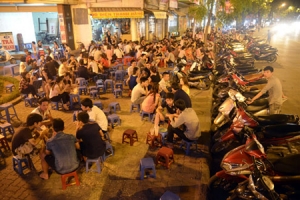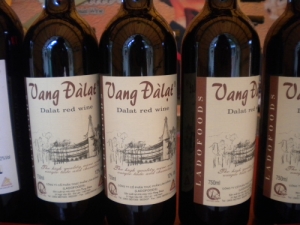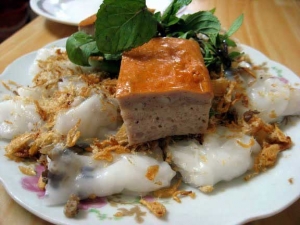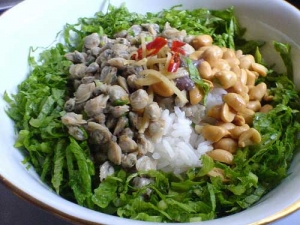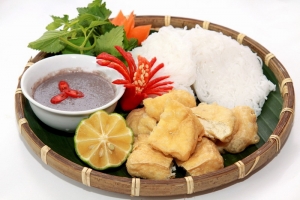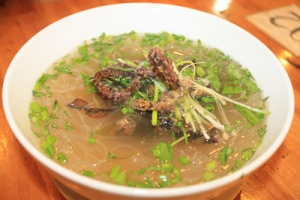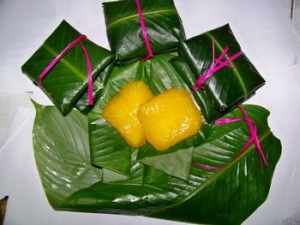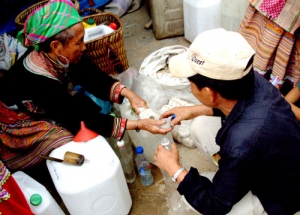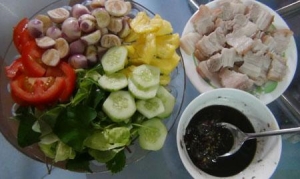
Asia Pacific Travel Team
Drink tea on the streets in Hanoi
In Vietnam, tea is appeared in almost every social activities such as wedding, anniversary and ritual ceremonies. In the early morning, tasting a cup of hot teaf ter breakfast it's awesome, some iced tea at “quán cóc” - the roadside-make-shift shop while waiting for your friend, or a whole day chilling out in a teahouse; that is the way tea penetrates into Vietnamese’ daily life.
Tea is sold popularly in “quán cóc” - or street vendors - which can easily be found in front the gate of bus terminals, train stations, offices, schools, or even in some corners in quiet alleys. “Quán cóc” with hot or iced green tea is an interesting piece of Vietnamese street culture, where people, in particular workers and students, often come to have some rest in short breaks of utterly exhausted working time, picking up children after school or waiting for friends. “Quán cóc” connects people, to share stories and hear latest news happening while smoking cigarettes or having some peanut candy.
Today, Hanoi youngsters have found out a new trend is that gathering around and chill out at new type of “quán cóc” called “trà chanh”(meaning tea with fresh lemon). Several plastic short-legged stools, a small dish of roasted sunflower seed, and certainly, a glass of “trà chanh” for each one; those are enough for everybody to have a great time at a very cheap price. “Trà chanh” is so popular that it even becomes a slang used widely by youngsters referring to “hang out”. The most exciting place to drink “trà chanh” in Hanoi is at the area around Saint Joseph Cathedral, Dao Duy Tu street and Ly Quoc Su street, where one will get a chance to have a close approach to daily life of the youth , listening to their talks about all the hottest events, music, fashion vague, technology and any gossips that one can think of.
Source: VNO
Vang Dalat (Dalat red wine) - in list of top wines in Vietnam
Unlike its more sophisticated brethren in France, Northern California or South Africa, Vang Dalat ( Dalat red wine) uses table grapes from nearby Phan Rang - a Vietnam's main grape-growing region. According to Nguyen Van Viet who has been with his wine company since 1999 explains that Vietnam has a limited history with wine. The French introduced an elite wine culture pre-1954, and during the past decade, because of the improvement in living standards, more people fond of traveling overseas and being exposed to foreign wines.
With this in mind, Viet considered how Vang Dalat could produce a European-style wine similar to traditional Vietnamese wines that any family could afford. Nowaday, his company produces 1.5 million liters of wine a year, including a Superior Red (all grape, 11% alcohol), Strong Red (grape/mulberry blend, 16% alcohol) and even a sparkling white, etc.
In the meantime, Vang Dalat is just one more good reason to visit Vietnam. If you travel to Dalat, we recommend dinner at Maison Long Hoa, a genteel establishment run by a Vietnamese Francophile. Classical rather than tinny pop plays over the stereo, hearty Vietnamese food offers comfort against the chill outside, along with the strawberry wine made by the owner's wife.
Have you ever drunk beer in Vietnam?
Bia hoi bars will give you the opportunity to relax drinking in a typical Vietnamese bar surrounded by the hustle and bustle of everyday life, especially in summer, lots of Vietnamese men like sitting in Beer bars with their friends after a long working day. Every traveler can easily find these bars to experience what the locals are enjoying.
Some most popular beer brands among the Vietnamese are Bia Saigon Special, Hanoi,Tiger, 333. One of those, Bia Saigon is also available as little stronger export version. Bière Larue is also good, and tourists can find local brands in every larger city.
Several famous places for beer, besides those around the Old Quarter, Lan Chin and Hai Xom Restaurant chain in Hanoi or Pham Ngu Lao area in HCM City. It might be fun to join in with the locals but beware that waiters at these restaurants do not know English to communicate with foreigners. However, they will know if you want a beer,
The beer at bia hoi corner is from a small local brewery, and varies in quality by the batch. At VND 5,000 (roughly 35 cents) a pint, it is really cheap (cheaper than water). If you're ready to try Bia Hoi, be prepared and drinking with the pros is not for the meek!
Banh Cuon (steamed rice rolls)- a favourite food of Vietnamese
For many years, Bánh Cuốn (Vietnamese steamed rice rolls) has never stop to demonstrate its long-lasting perfect comfort food to food lovers. For those are familiar with Bánh Cuốn, it become favourite breakfast food. For those have not yet ever try the dish, once taste it, you soon fall in love with its flavor.
How to make it?
Starting with a steamed rice roll cooked on a pot, covered by thin fabric, until it is very thin. Then it is scrapped off the pot with a flexible bamboo stick. After that, the roll is filled with a mixture of pork, wood ear mushrooms, onions, and fish sauce.
When and where to eat?
Banh cuon stands face their rush times during breakfast and dinner, so it is difficult to find stalls still selling the dish in late morning or evening.
Use your better judgment when eating from street vendors, but on average I find that banh cuon carts are some of the cleaner carts on the street, and wearing plastic gloves is a common practice among these vendors. A plate will usually cost between 15,000 and VND20,000 on the street and, if you are afraid of the carts, between 25,000 and VND50,000 in some local restaurant.
Com Hen( Rice with baby clams)- an attractive speciality of Hue
Con Hen is served with a little rice and a lot of vegetables, herbs and fruit, add clams in the center, top with fried pork fat, roasted peanut, fried shallots, or you can drizzle on some fermented shrimp sauce and clam broth.
It requires fifteen different raw materials to prepare for the dish, including mussel, watery grease, fried grease, peanuts, white sesames, dry pancake, salted shredded meat, chilly sauce, banana trunk, banana flower, sour carambola, spice vegetables, peppermint, salad, etc.
What makes this simple kind of food popular is revealed in the great endeavor to adopt and process its main ingredient – mussel. Mussels are sea species, which must be dipped in water for a long while before being processed.
Moreover, it is a low-priced specialy, thus you could eat it in luxurious restaurants in Hue or even in vendoring mobile shops on the streets.
" When visiting Hue you could not miss Com hen!" is the most common remark of visitors elsewhere to Hue. So, let come and enjoy it yourself!
Bún đậu mắm tôm- delicious food for breakfast
“Mắm tôm” or Shrimp paste is popular in many parts of Asia including Vietnam. As a matter of fact, it has long been in the list of “worst smelling foods in the world”. I know what some of you may react to this dish: “Ewww”, but come on. one of the reasons why you travel is to see (hear, smell, taste, feel) the world in all its diversity, isn’t it? So why not give “mắm tôm” a chance?
Besides, to you, shrimp paste may smell like a rotten animal, but to many locals, it is an aroma that makes their mouth water only thinking about it. After two or three times, trust me, you may feel pity if refusing to try this seemingly gross local food.
“Mắm tôm” is made from shrimps and salt. The typical aroma comes from an enzyme which is available in the intestine of shrimps. Actually, “mắm tôm” smells exactly like the smell of the mustard-colored stuff in shrimp heads. The fermentation may take from six months to one year before mắm tôm can be served, normally with “nộm” sweet and sour grated “rau muống” water morning glory, “cà pháo” egg-plants, “thịt chó” dog meat and of course, “bún đậu mắm tôm”. You can surely guess, “bún đậu mắm tôm” comprises of noodles “bún”, tofu “đậu”, shrimp paste “mắm tôm” and, last but not least, odoriferous herbs “rau thơm”, which is optional but they will make the difference. “Rau thơm” can be basil “rau húng” or cockscomb mint “kinh giới”.
It is not difficult to find a street vendor that offers you this food. You will notice that the vendors do something to the shrimp paste before giving it to you: they will add a few drops of a fresh lemon or satsuma “quả quất” and then some boiling oil from the same pan they are using to fry tofu. You will have to mix the whole thing well until the bowl is full of soft tiny white bubbles, which is how they make the smell less strong . Dip a piece of tofu, some noddles and a basil leaf into the sauce and eat them all together, you will feel heaven (my mouth is watering!).
However, it shouldn’t be a big deal if you don’t like it first time but remember when I had my first bite of durian, I almost threw up. Guess what, now I’m really in love with this fruit.
A dish of “bún đậu mắm tôm” in the street often costs from VND20,000 VND (US$1), quite cheap, which is one of the reason why I love street foods. Of course, the vendors will always give you two options: “mắm tôm” or fish sauce “nước mắm”. But, you know, there must be some reason why peole call it “bún đậu mắm tôm” and never “bún đậu nước mắm”. Last thing, you may want to prepare some pieces of chewing-gum to have after eating this very special food.
I hope that after reading this, instead of referring to “bún đậu mắm tôm” as “one of the weirdest foods”, you may want to recommend it to your friends as a special feature of Asian cuisine.
Source: hanoitimes
Miến Lươn (Eel vermicelli)
The Miến Lươn is simple with vermicelli and crispy eel, broth and some fragrant herbs. Having the dish, we feel the eel meat is crispy and melting in the mouth. with the fragrance of herbs in the broth bowl. The hot bowl of Miến Lươn is suitable with the rainy days. However, the eel meat has the property of coldness; therefore it is very good to eat in hot days.
The main ingredient of this dish is eel. Besides, banana flower and vermicelli are other important elements. Banana flower should be fresh and ripe. Vermicelli must be made from high quality phrynuim fruits and are small, pure threads .
Eels are washed carefully with vinegar, removed the inside , mixed with spices like red chilli, onion, pepper, fish sour (nước mắm) and then fried in hot oil until fragrant and yellow. Banana flower is cut into thin threads and soaked in salt water to remove resin and keep it white. Vermicelli is put into cool water for 5-7 minutes and then fried with mashed onion . Eel vermicelli noodle is often eaten with ginger, “ lá lốt” and lemon juice. The crispness and pleasant smell of yellow fried eels, the acrid , buttery and sweet taste of banana flower accompanied with the spiciness of ginger , chilli , the pungency of “ lá lốt” and the sourness of lemon juice converge on the eel vermicelli bowl that make a try worth a thousand words.
The eel is fried crispy with the size of a big chopstick. When eating this food, there are two ways of eating Miến Lươn with the mixed dry one and the water Miến Lươn. The mixed Mien Luon (Eel vermicelli) is similar to the dry noddle with seasoned and sauté beef (Hủ Tiếu) of the South, nevertheless, the vermicelli is blanched with boiling water, mixed with spices and topped with some crispy fried eel.
Source: vietnamcharm
Phu The Cake: serve for wedding ceremonies in Vietnam
If you visit Dinh Bang Village in Bac Ninh Province, probably you should not miss a specialty: phu thê (husband and wife) cake, a traditional cake made from local materials representing marital fidelity, originating from the time of the Ly dynasty.
The skin of the cake is made by grinding and filtering large-sized grain glutinous rice to retrieve the starch. The starch of this rice will be mixed with scraped green papaya and soaked in the juice of the fruit of cape jasmine, which makes the skin both crispy and glutinous and gives it a light yellow color. The stuffing is made of green bean ground with sugar, sugar coated lotus seeds and coconut meat. After stuffed, the cake is wrapped into a square shape in leaves from phrinium and coconut trees and boiled in hot water.
The whole cake is made by hand and each household in the village has their own secret recipe passed down through generations, creating their own tastes and brands for the cake.

Phu The Cake
It is said that the kings of the Ly Dynasty encouraged agricultural expansion and in their period Dinh Bang and other villages in the country had bumper crops. During the Lunar New Year and festivals, the locals of Dinh Bang used these agricultural products to make a cake named su se to make offerings to the ancestors. Once, King Ly Thanh Tong (1023 – 1072) and his wife Y Lan visited the village for a festival and had a chance to taste this cake. They complimented this cake, renamed it to phu the cake and asked the villagers to make it for wedding ceremonies to celebrate the happiness of the couple.
After the cakes are boiled they are wrapped in green banana leaves and tied in pairs with bamboo strings dyed in pink, as an icon of the loyalty of the love between husband and wife.
Vietnamese people know about the cake in the whole country now, and the Cake is made all year round in the markets of the village. In some areas it is wrapped in a square box of banana leaves to offer as a gift.
Feeling the quintessence of sky and land when drinking Bac Ha corn wine
Located in Lao Cai province, Bac Ha is famous for the color of pompous clothes of women and girls in mountainous area, for the white color of plum tree in spring, and also for the deep alcohol yeast of corn wine.
Corn wine is cooked from the unique material which is planted in the corn terraced-field of Hmong people. Maybe the combination of quintessence of sky and land of the mountainous are, hence the corn is very firm and nutritional here.
Together with a special glaze from a type of seed like millet, Hmong people have created a unique wine which is not similar to any other wines of the West North mountain area.
Just uncork the bottle; you can know that is the Bac Ha corn wine. When the first drop of wine touches your lips, you would feel the heat running across the body. The feeling spread out so you just drink and being drunken without headache or dazzled. Perhaps, this is the secret to protect them from the coldness of mountainous area every winter.
Corn is planted everywhere, and so does wine in the market. Nevertheless, the most interesting corn made in Street village (Ban Pho) could not be caught up by any other.
Although wines are hot and torrid, but when drinking this wine, you could feel the quintessence of sky and land. People say Ban Pho village (village of Chinese Hmong people that is 4km from Bac Ha) has a precious and pure water resource which is Hang De spring. Therefore, people in Ban Pho could make such a nice wine. Corn wine and millet are mixed and being sullen in cast iron bucket for about one week.
Nowadays, tourists in Vietnamtravel could buy this wine everywhere in Sapa or Bac Ha. The corn wine with specialty of markets could be the unforgettable in your trip.
Source: vietnamesecuisine.org
Unusual foods from Central Vietnam
Among them are fermented fish intestine and fermented squid. Fermented squid eaten with boiled pork, herbs and vegetables
Central Vietnam may be a barren land but it has given the country many delectable food items. Among them are fermented fish intestine and fermented squid.
There are some kinds of fish whose intestines too are delicious. Tuna, for instance. But normally you would expect the intestine to be cooked and eaten just like the flesh. But, strangely, the intestine is turned into a delightful paste in Binh Dinh Province.
To make it, get the intestine of triggerfish or tuna, ensuring it is large and fresh.
It is not necessary to wash it because it is not dirty and does not contain any toxic substance. But remove the gall bladder to make sure the paste is not bitter. With a sharp knife make a delicate cut to drain the viscous substance inside.
Then cut it into small pieces, put in a container or glass jar, and add salt, with one portion of salt for two portions of intestine. Cover the jar tightly and put it in the sun for three to seven days. The intestine shrinks and becomes a paste.
Fifteen days later, after soaking up the salt, it produces a dark liquid. It takes another two to three months to get the extract, which no longer smells fishy. Throw away the intestine and use only the thick sauce.
It is tasty and fragrant, delicious when eaten with hot rice, vermicelli, bánh hỏi (fine rice vermicelli), or bánh cuốn (steamed rice rolls).
To make it even tastier, put a pan over low heat, add some oil and chopped garlic for fragrance, and then the sauce. Stir it well and add some sugar and seasoning to get a greasy dark sauce that smells good. You can add chilli to make it spicier.
Fermented squid
Cuttlefish paste is made in a similar manner. Choose fresh fish with firm flesh, and wash but not clean its intestine.
To prepare the paste, a specialty of Quang Ngai Province, mix one bowl of salt with three bowls of the intestine, mix well, and put in a container.
It ferments and usually turns black because of the internal ink bag. It is advisable not to discard the bag because locals think it is the extract of the squid. If it is removed, the fermented squid turns lighter but also less tasty.
The fermented squid can be eaten raw, but the texture is somewhat tough. So people often chop it into small pieces and put it in a bowl of chopped ginger, chili, and garlic. Then, add some chopped pineapple and one will have delicious sauce. It is eaten with hot rice and herbs and vegetables.
If you don’t fancy raw fermented fish intestine or fermented squid, add pork belly and braise to get a delicious dish.
Mix the pork belly with the paste, add some seasoning and sugar, then put in a pan over low heat. Braise until the meat soaks much of the paste and the latter turns thicker.
By Nguyet Anh, Thanh Nien News (The story can be found in the July 27th issue of our print edition, Vietweek)


